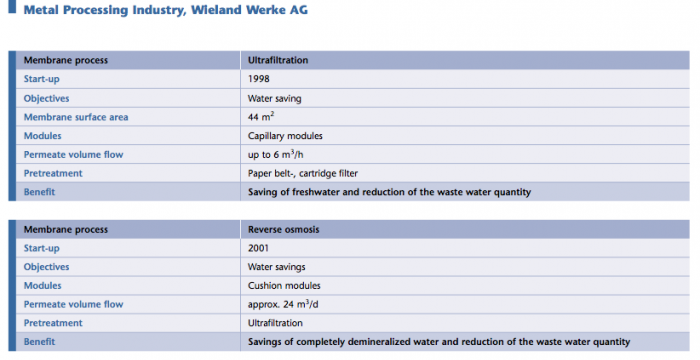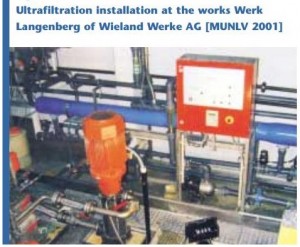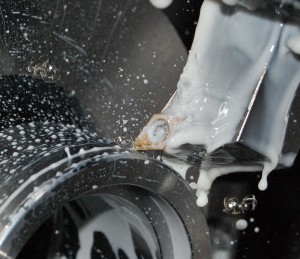Water Recycling and Reuse in Metal Processing
In 1998, a concept for water saving was realized in the works Langenberg which had been tested before in detail. This was done in cooperation with the company Dr.-Ing.Peters Consulting für membrantechnologie und Umwelt-technik (CMU), Neuss, and der RWW Wassertechnologie GmbH, Nettetal, and with a financial subsidy from the land Nord-Rhine Westphalia. According to this concept, the waste water from the brushing machines is treated by ultrafiltration in dead-end mode, after having passed a paper belt-and a cartridge filter. Each of e four brushing machines integrated into this concept forms an internal “local” water cycle with an ultrafiltration installation. The capillary modules from X-Flow have a total filter surface area of 44 m2 and produce up to 6 m2 of filtrate per hour, at a transmembrane pressure of up to max. 1 bar. The filtrate is reused in the brushing machines. |
 | ||
The particle-containing water (0.5 m3/h per installation) from back washing of the ultrafiltration is fed into the internal water cycle. With this, the water quantity in this cycle as well as the freshwater demand and the consumption of neutralization and precipitation agents is reduced by 60%. The resulting sludge, which contains copper, is used in the iron and steel industry. |
| Ultrafiltration installation at the works Werk Langenberg of Wieland Werke AG | |
| The permeate is deionized as far as possible so that completely deionized water, which is very expensive, for the rewashing process can be saved | |
The enterprise described above is the first cold-rolling mill for non-ferrous metals which uses ultrafiltration in dead-end operation and low-pressure reverse osmosis. The use of these methods represents and improvement in the state of the art for this field. | |
| The environmentally relevant investments (229,800 Euro, which a subsidy of the Land NRW of 100,000 Euro) are profitable: Besides the waste water quantity which now is only approx. 4 m3 per hour, the water consumption, too, was clearly reduced (by up to 90%) by internal recirculation. Moreover, by ultrafiltration as well as low-pressure reverse osmosis the particular and dissolved substances are removed as far as possible from the individual water cycles, so that the surfaces of the final products are of constant high purity. |  |

